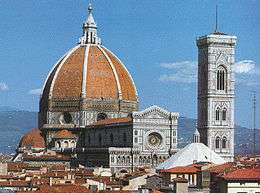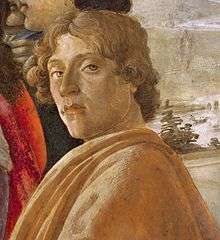The Mystical Nativity
 | |
| Artist | Sandro Botticelli |
|---|---|
| Year | c. 1500–1501 |
| Medium | Oil on canvas |
| Dimensions | 108.5 cm × 74.9 cm (42.7 in × 29.5 in) |
| Location | National Gallery, London |
The Mystical Nativity is a painting of circa 1500–1501 by the Italian Renaissance master Sandro Botticelli, in the National Gallery in London. Botticelli built up the image using oil on canvas.[1][2] It is his only signed work, and has an unusual iconography for a Nativity.
The Greek inscription at the top translates as: "This picture, at the end of the year 1500, in the troubles of Italy, I Alessandro, in the half-time after the time, painted, according to the eleventh [chapter] of Saint John, in the second woe of the Apocalypse, during the release of the devil for three-and-a-half years; then he shall be bound in the twelfth [chapter] and we shall see [him buried] as in this picture".[3] Botticelli believed himself to be living during the Tribulation, possibly due to the upheavals in Europe at the time, and was predicting Christ's Millennium as stated in Biblical text.
It has been suggested that the painting may be connected with the influence of Savonarola, whose influence appears in a number of late paintings by Botticelli,[4][5] though the contents of the image may have been specified by the person commissioning it. The painting uses the medieval convention of showing the Virgin Mary and infant Jesus larger both than other figures, and their surroundings; this was certainly done deliberately for effect, as earlier Botticellis use correct graphical perspective.
Historical context and puzzling aspects
The Mystical Nativity depicts a scene of joy and celebration, of earthly and heavenly delight, with angels dancing at the top of the painting. At the top of the painting Sandro Botticelli's name – but also the apocalyptic and troubling words. And there are dark premonitions – the helpless child rests on a sheet that evokes the shroud in which his body will one day be wrapped, while the cave in which the scene is set calls to mind his tomb. The Kings on the left bear no gifts, but their own devotion. At the top of the painting twelve angels dressed in the colours of faith, hope and charity dance in a circle holding olive branches, and above them heaven opens in a great golden dome, while at the bottom of the painting three angels embrace three men, seeming to raise them up from the ground. They hold scrolls which proclaim in Latin, "peace on earth to men of goodwill". Behind them seven devils flee to the underworld, some impaled on their own weapons. In Renaissance times Last Judgment paintings showed viewers the reckoning of the damned and the saved at the time of Christ's Second Coming. In echoing this kind of painting the Mystical Nativity is asking us to think not only of Christ's birth but of his return.." (Jonathan Nelson, Syracuse University in Florence).
The painting emerged from the city of Florence in a time when the fanatical preacher Savonarola held the city in its grip. He had arrived in Florence in 1490 but had been repelled by the artistic glory and enormous wealth that so impressed the world. He preached that this was a corrupt and vice-ridden place. A great scourge was approaching – and then his words had assumed a terrifying reality: the Italian War of 1494–1498. In 1494 a huge French army invaded Italy and 10,000 troops entered Florence so that the Florentines feared the King of France meant to sack the city. Savonarola stepped into the political vacuum, he met with the French king and persuaded him to leave Florence peacefully. In their gratitude and relief the Florentines increasingly saw the friar as a prophet and his preaching attracted huge crowds to Florence Cathedral. Savonarola claimed that Florence could become the new Jerusalem if the citizens would repent and abandon their sinful luxuries – and that included much of their art. His beliefs were made real as groups of evangelical youths went on to the streets to encourage people to part with their luxuries, their lewd pictures, and books, their vanities, combs, mirrors. Botticelli may well have seen his own paintings fed to the flames. Yet the artist might not have objected because, like much of the city, he too had come under the sway of Savonarola. It seems that a sermon preached by Savonarola bears directly upon the Mystical Nativity.

In one sermon Savonarola preached he set forth a vision that had come to him in which he saw an extraordinary heavenly crown. At its base were twelve hearts with twelve ribbons wrapped around them and written on these in Latin were the unique mystical qualities or privileges of the Virgin Mary – she is 'mother of her father', 'daughter of her son', 'bride of God' etc. Though much of the writing on the ribbons held by the dancing angels is now invisible to the naked eye, infra-red reflectography has shown that the original words on the angels ribbons correspond exactly to Savonarola's 12 privileges of the Virgin. In his sermon, preached on Assumption Day, Savonarola went on to explore the 11th and 12th chapters of the Book of Revelation – the precise chapters mentioned in the painting's inscription. He connected the glory of Mary with the imminent coming of the power of Christ on earth.[6]

For years Savonarola held Florence in his hand but his hard line charismatic rule made him powerful political enemies. He was challenged to prove his holiness by walking through fire and when he refused the tide of opinion turned against him. He was arrested, and under torture confessed to being a false prophet. On 23 May 1498 he was hanged with two of his leading lieutenants, their bodies burnt and their ashes scattered in the river Arno. Some see the figures of the three men at the bottom of the painting as representatives of the three executed holy men, raised up and restored to grace – but persecution not peace awaited Savonarola's followers and it was in an atmosphere of oppression that Botticelli set out to create the Mystical Nativity.
The painting is on canvas – normally he would have used wood panel – perhaps for a painting with a dangerous message, canvas had the advantage that it could be rolled up and hidden. With his canvas prepared he would sketch a detailed design on paper, then he transferred this to canvas. He drew on many sources – the dancing angels echo his own three graces of Primavera, the scurrying devil was inspired by a German woodcut. X-rays show that very little of the original design changed – only an angel's wing was adjusted and trees added over the roof of the stable. Botticelli was now ready to build up the image using tempera paint – the canvas was an experimental medium. To create the heavenly dome Botticelli called on the goldsmith's craft he had learned as a boy. "The symbolism of the gold is to do with the unchanging, untarnished nature of heaven – gold doesn't decay, it doesn't darken like silver. Botticelli would have used an adhesive layer made of oil mixed with resin – not burnished, the gold just patted down on to the surface, following the surface irregularities of the canvas – a glitter, intricate, it would have helped the jewel like quality of the painting – it would have drawn the eye upwards from the Nativity into Heaven. Faith, hope and charity, [the angels clothed in] white, green and red – but the copper based green pigment has discoloured with time, to bronze. Originally it would have been vibrant." [7]
Fate of the painting

Botticelli died in 1510. The Mystical Nativity remained hidden for another three centuries. Rome at the end of the 18th century was very different to Renaissance Florence – except for the presence of French invaders. Many foreigners left, but not a young Englishman, William Young Ottley. He was an art lover, and wealthy with a slave plantation in the Caribbean. He bought up many paintings cheaply. At the Villa Aldobrandini he saw a small, unknown work, Botticelli's Mystical Nativity. Botticelli was then in obscurity.
It arrived in London where Ottley's house became in effect a private museum of Italian masterpieces. After Ottley's death William Fuller Maitland of Stansted picked up the painting at an auction for £80. When he loaned it to the Art Treasures Exhibition, Manchester 1857, it was now on open display. The exhibition's newspaper the Art Treasures Examiner printed a new engraving of it.

From the moment Botticelli's art is shown in Manchester there's a real change in opinion about his work and certainly by the late 1870s, 1880s Botticelli becomes a real cult figure – somebody the artists who aspire to be on the cutting edge of the art world are looking to...Dante Gabriel Rossetti and Edward Burne-Jones both adapted elements of it for their own work. Burne-Jones copied some of Botticelli's illustrations for Dante's Divine Comedy into his own sketchbooks. Rossetti demonstrated his affection for Botticelli's work by buying his portrait of Smeralda Bandinelli in 1867.[9]
John Ruskin helped to give the painting its name; after seeing it in London he referred to Botticelli's 'mystic symbolism'. When Maitland died the National Gallery in London stepped in. According to Nicholas Penny the Gallery "was concerned to buy works from the earlier Renaissance – previously it had been its top priority to buy masterpieces which there would be no controversy about at all. There was an element of avant-garde excitement about buying pictures like this in the 19th century." The Gallery had to find £1500, being nearly 20 times what it had fetched just thirty years earlier.
References
- ↑ http://www.nationalgallery.org.uk/paintings/sandro-botticelli-mystic-nativity/*/key-facts
- ↑ Rupert Featherstone, Hamilton Kerr Institute, Cambridge, speaking on The Private Life of a Christmas Masterpiece, BBC 2009
- ↑ National Gallery
- ↑ "Botticelli's Mystic Nativity, Savonarola and the Millennium" by Rab Hatfield in Journal of the Warburg and Courtauld Institutes, vol. 58, 1995 (subscription required)
- ↑ The Private Life of a Masterpiece
- ↑ Rab Hatfield, Syracuse University in Florence, speaking on The Private Life of a Christmas Masterpiece, BBC TV 2009
- ↑ Rupert Featherstone, speaking on The Private Life of a Masterpiece, BBC TV December 2009
- ↑ Suzanne Fagence Cooper, speaking on Private Life of a Christmas Masterpiece
- ↑ Suzanne Fagence Cooper, speaking on the BBC programme The Private Life of a Masterpiece and Pre-Raphaelite Art in the V&A, V&A Publications 2003
